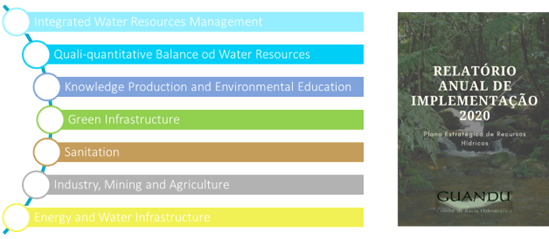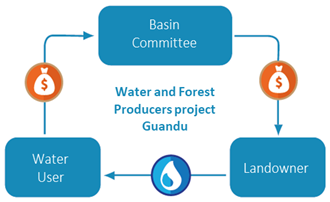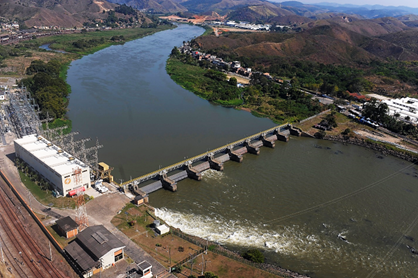Summary
The Guandu river basin has diversified land use as well as large industries and urban centres downstream. This basin is responsible for the generation of electricity for Rio de Janeiro’s Metropolitan area, given its large installed hydraulic capacity. This area also has a considerable number of traditional communities such as the Quilombo dos Palmares.
The Guandu river is crucial for Rio de Janeiro’s communities and urban centres as it is the catchment area of the Guandu Water Treatment Plant (GWTP), which is the largest water treatment plant in Latin America and the source of water supply to the Rio de Janeiro’s Metropolitan area.
In order to manage this complex hydrographic system, the State Water Resources System was created. In this system, the Guandu Basin Committee is defining actions in its Strategic Water Resources Plan, while the Association for Pro-Management of Waters of the Paraíba do Sul river basin known in Portuguese as Associação Pró-Gestão das Águas da Bacia Hidrográfica do Rio Paraíba do Sul (AGEVAP) is the water agency which puts the financed actions into operation. The basin committee and water agency have developed a Strategic Water Resources Plan which is divided into eight Thematic Agendas and several lines of action. These thematic agendas provide a roadmap to how stakeholders can implement the agreed objectives for the future.
An action highlighted is the Water and Forest Producers project, in which 74 rural landowners participated in the conservation of 4,098.07 hectares of the Atlantic Forest biome and the restoration of more than 506 hectares of deforested areas. In addition, the basin benefits from other actions such as implementation of the Guandu Basin Integrated Water Management System, and both rural and urban projects.
The Guandu River Basin in Brazil, Source AGEVAP
Problem:
- Water scarcity and overexploitation
- Floods and droughts
- Pollution and public health issues
- Loss of natural heritage
Solution:
- Operationalization of the State Water Resources System;
- Maintenance of the billing system;
- Implementation of actions in the Strategic Water Resources Plan through conservation practices, respecting traditional communities, reducing the domestic organic load and developing and operating the basin’s Geographic Information System (GIS).
1. The Problem
The Guandu river basin, located in the southeast of Rio de Janeiro State, is home to 15 cities and the largest Water Treatment Plant in Latin America. The Guandu Water Treatment Plant (GWTP) treats approximately 92% of the water consumed by the more than 12 million inhabitants of the Rio de Janeiro’s Metropolitan Region (RJMR), making the Guandu basin a source of crucial importance.
This basin receives water of up to 160 m³/s from the Paraíba do Sul River. Water allocation and distribution across the basin has been historically a contentious affair. Although the reservoirs are mostly located in the state of São Paulo, two thirds of the flow of the Paraíba do Sul is siphoned off to the Guandu River in the state of Rio de Janeiro to supply metropolitan Rio de Janeiro. This water distribution is essential for the water supply of the traditional communities, the population in the metropolitan region and the development of industrial areas.
The hydrographic region of the Guandu is mountainous, and several sections of this basin are susceptible to erosion. This situation is exacerbated when combined with extensive high-impact livestock faming. As a result, the landscape and rivers are affected by erosion, suffer from siltation and, in many cases, this leads to the loss of the ecological function of the shores, highlighting the urgent need to recover ecosystems and the natural landscape. In addition to the main challenges of the management of the Guandu basin, the loss of vegetation cover accelerates the degradation of soils and, consequently, of water sources. Proper land use benefits water resources and is an important factor in income generation as it sustains the livelihoods of communities.
Although there is a high level of water treatment, only 34% of the sewage produced is collected. Of this, only 2.3% is treated, which directly affects water quality. This creates difficulties for the proper operation of Guandu Water Treatment Plant and, consequently, generates insecurity and a lack of trust in the water supply for the inhabitants whose daily activities depend on the Guandu river.
2. The solution
The State Water Resources System and its Sustainability
In order to guarantee the availability of water and improve its quality, the Water Resources Policy of Rio de Janeiro State was implemented by Law No. 3,239/99. The main objective of this policy is to promote harmonization between the multiple uses of water, guaranteeing it for future generations. In addition, it seeks to articulate the political, social and economic actions to promote the recovery of aquatic ecosystems, the prevention of erosion and the clean-up of rivers and aquifers.
With an emphasis on regional and decentralized action, the state’s water resources law created basin committees. These committees are collegial entities composed of representatives from society, water users and government agencies, which have normative, deliberative and advisory powers. Among their main responsibilities, basin committees must approve the water resources plan for their basin, as well as the prices to be charged to water users.
The water resources plan is the instrument that maps the current situation of the river basin through its socio-economic, institutional and environmental characteristics. In this document, the state of aquatic ecosystems and the water balance of the basin is elaborated and, based on its results, it formulates sectoral programs and actions. The actions foreseen in the basin plans are financed by fees paid by users that carry out diversions and water withdrawals or discharges of wastewater or other liquid or gaseous wastes into the water bodies.
The pricing system for the use of water resources aims to recognize water as a limited natural good, endowed with economic value, indicating to the user its real value while encouraging its rational and sustainable use. This system can also be defined as the value attributed for the use of a common resource in the form of an economic instrument based on pricing mechanisms, whose public prices are defined by the basin committees and collected by the competent governmental agencies.
The priority actions defined by the committees in their basin plans are financed with the collected resources and managed by a water agency. According to the state water resources law, water agencies are non-profit executive entities with their own legal personality and financial and administrative autonomy which, in addition to carrying out defined actions, are responsible for implementing the Water Resources Information System in the basins in which they operate.
Thus, in the Guandu river basin, the following were created:
- The Guandu Committee, which is in charge of defining the basin management operations;
- The AGEVAP, which acts as a water agency in the execution of the actions foreseen in the Strategic Water Resources Plan; and
- The water use billing system, whose financial resources come from the payment made by water users and collected by INEA, an agency of the Rio de Janeiro State, responsible for the water resources policy.
The Guandu’s Water Resources Strategic Plan
The basin committee and water agency has developed a Strategic Water Resources Plan for the Guandu River Basin which is divided into eight Thematic Agendas and several lines of action. The actions have short-, medium- and long-term horizons and are in accordance with priority needs to guarantee the basin’s water availability and quality. Among the Thematic Agendas, the Integrated Management of Water Resources, Green Infrastructure and Sanitation agendas stand out, as they represent the largest investments made by the Guandu Committee. These thematic agendas can provide a roadmap to how stakeholders can implement the agreed objectives for the future.
The Integrated Water Resources Management Agenda aims to strengthen institutional relations based on the improvement of water resources management instruments (e.g., billing system) and on the monitoring of water quantity and quality, while ensuring the transparency of the actions through an efficient information system. On the other hand, the Sanitation Agenda provides adequate planning for the expansion of urban and rural sanitation services in the Guandu basin, promoting the improvement of wastewater collection and treatment, solid waste collection and treatment and water supply. Finally, the Green Infrastructure Agenda aims to ensure the restoration and conservation of ecosystems related to water resources, and to increase the vegetation cover of the basin.

Strategic Water Resources Plan agendas and Annual Implementation Report
Photo credit: Guandu Committe
Outcomes
Guandu in Action
The Green Infrastructure Agenda has a range of initiatives including the Water and Forest Producers project. The project adopted a payment system for environmental services which provided financial compensation to rural producers who were actively conserving forest remnants of the Atlantic Forest on their properties. The project includes actions of forest restoration, recovery and protection of water sources, springs, riparian forests and other priority areas, promoting the gradual restoration of land cover, mitigating erosion processes and recovering the native forest. These conservation practices contribute to the provision of ecosystem services, bringing benefits to the hydrographic basin and to its population, reducing the pressure on the water sources.
To determine the amount to be paid per hectare of conserved forest, indicators that reflect the state of conservation of the forest remnants are taken into account. In addition, the conservation practices applied in line with the property management characteristics, give greater value to properties with increased potential for the provision of environmental services.
The Water and Forest Producers Water Fund is supported by the Green-Blue Water Coalition, a TNC initiative in collaboration with key Brazilian companies from different sectors, and civil society and the Latin American Water Funds Partnership. Today, the financial resources for payment for environmental services providers and forest restoration actions come from the billing system for the Guandu river basin water users, with the Guandu Committee as the intermediary. In addition to compensating producers who dedicate themselves to providing environmental services, the project contributes to the socioeconomic and environmental development of the region.

Logic of the user-payer and the provider-receiver with the basin committee as an intermediary
For the operation of the project, the financial resources are transferred to AGEVAP, which maintains the agreement with the administration of the envisaged municipality. Through this agreement, the financial resources are transferred to the rural producers under contract. The city is responsible for issuing calls for the selection of environmental services providers, hiring rural landowners and paying producers.
A second contractual instrument is signed between AGEVAP and another institution such as an NGO or a private company, which will be responsible for carrying out conservation and restoration actions on rural properties.
Currently, the project has the participation of seventy-four rural properties, which has led to the conservation of 4,098 hectares of Atlantic Forest and the restoration of more than 506 hectares of deforested areas.
Recently, an increase in forest cover has been noted in Rio Claro city, presumably as a result of the project, since the increase observed in participating properties was greater than that observed in non-participating areas.
Among these rural properties is the traditional community of Quilombo dos Palmares, located in the area covered by the project in Rio Claro city. In addition to the undeniable environmental services provided, the community played a central role in the development of the project, as its inhabitants collaborated directly in conservation and restoration activities.
The Water and Forest Producers project Guandu – Source : https://www.fondosdeagua.org/ – Produtores de Água e Floresta Guandu-RJ
Annually, the Guandu Committee allocates approximately 68,000 Euros to the payment of producers in the project. Since its inception, approximately 430,000 Euros have been invested by the Guandu Committee for implementation and monitoring activities.
In addition to paying the producers who are dedicated to providing environmental services, the project contributes to the socioeconomic and environmental development of the region. This is evidenced by the increase in income of contracted rural landowners, the movement of local commerce and by the generation of direct and indirect employment.

Training event held with members of the Water and Forest Producers project; Photo credit: Guandu Committee
In addition to the efforts to recover and maintain the ecosystems of the basin, the Guandu Committee works simultaneously investing in sanitation infrastructures in rural and urban areas that have a direct impact on the water supply in Rio de Janeiro’s Metropolitan area. Throughout 2020, the committee and AGEVAP developed an umbrella project with ninety-six rural sewerage projects throughout the basin, which will be able to collect wastewater from approximately 46,000 inhabitants.
The sanitation solutions in this project are closely aligned with the needs of each rural community, taking into account technical aspects such as low operating costs. With the implementation of AGEVAP projects, it is expected that more than 7,500 m³ per day of wastewater generated in the rural areas of the basin will be treated, which will have a direct impact on the quality of the water consumed by the communities themselves and the metropolitan area, further reducing the risk of waterborne diseases.
The Guandu Committee has also invested in sewerage projects for urban areas that have a significant impact on the basin’s water resources. In 2018, the committee completed projects for eight cities and is currently developing projects for six more.
3. Lessons learned from the Guandu river basin experience
With almost 20 years of history, numerous actions carried out and a proven planning dynamic, the Guandu Committee emphasizes the importance of synergy between urban development public policies and the watershed in order to preserve the environment.
Synergy between local communities and social or governmental organizations is essential to achieve common goals, such as those achieved by the Water and Forest Producers Project, which, with more than a decade of effort, has reached 4,500 hectares of preserved or restored areas, leaving its legacy and a space for improvement. In order for the initiative to become more ambitious, it is necessary to guarantee a greater influx of financial resources, which can be achieved through institutional support. Once financial resources are secured, the program will be able to expand its efforts and generate results on a large scale.
Forest restoration is being used as a strategy for the provision of environmental services, such as erosion control, increasing soil infiltration rates, mitigating the effects of floods and regulating water flows. As the water present in the water bodies is the result of soil use across the basin, water quality and flows can be impacted by deforestation and conversion of forests to agricultural land. For this reason, there is a prospect of expanding the Water and Forest Producers project to areas for crop production, where farmers would be encouraged to adopt conservationist practices in order to improve not only the provision of ecosystem services and but also the productivity and profitability of their property.
Monitoring and Communicating
The Guandu Committee communicates that not only tangible results should be celebrated, but also the development of the society through information. With this in mind, the Guandu Basin Integrated Water Management System has now been operational for over six years.
The system assists in decision making through a set of tools that support the monitoring of the basin’s geographic information, such as meteorological data and quality/quantity data of water bodies. Information is accessible so as to support the coordination process between the basin’s actors.
In addition to geographical and environmental information, the system relies on the availability of studies carried out by the Guandu Committee and AGEVAP and on information related to the projects being carried out in the basin, especially the “Water and Forest Producers” project so as to provide a complete picture of what is happening across the basin.
What are the drivers for action?
| Extreme Events | Declining water quality | Water availability |
| ☒ Public health hazards
|
☒ High operating costs
|
☒ Water supply disruption
|
| ☒ Damage to infrastructure | ☒ Loss of credibility and trust | ☒ Constraints to growth
|
| ☒ Economic activities and supply chain disruption | ☒ Environmental, cultural and health impacts | ☒ Declining quality of life |
For more information on the Drivers for Action visit the Action Agenda for Basin-Connected Cities.
Pathways for Action
| Assessment | Planning | Implementation |
| ☒Investment in data & information systems
|
☒ Risk-based approach to planning
|
☒ Integration of natural infrastructure
|
| ☐ Linking traditional water management with science
|
☒ Water allocation mechanisms | ☒ Economic and financing mechanisms
|
| ☒ Invest in values to motivate water decision-making | ☒ Stakeholder participation in planning and management | ☒ Building partnerships from catchment to tap |
| ☐ Aligning urban development with basin management
|
☒ Digital Technologies
|
For more information on the Pathways for Action visit the Action Agenda for Basin-Connected Cities.
4. Useful links and resources
Guandu Committee: http://www.comiteguandu.org.br
AGEVAP: https://www.agevap.org.br/
Guandu basin’s Strategic Water Resources Plan: http://www.comiteguandu.org.br/conteudo/AGVP_GUANDU_PRH-RF01_R01.pdf
Valuation methodology used in the Water and Forest Producers project: http://www.comiteguandu.org.br/resolucoes/2019/resolucao-143.pdf
Guandu basin’s Integrated Water Management System: http://sigaguandu.org.br
About AGEVAP
Created in June 2002, AGEVAP is a private entity with non-economic purposes. It was initially created for the exercise of the functions of Executive Secretary, and currently exercises the functions defined in Art. 44 of Federal Law No. 9.433 / 97, Art. 59, of Rio de Janeiro State Law No. 3.239 / 99 and Art. 38 of the Minas Gerais State Law nº 13.199 / 99, which deals with the competencies of the so-called water agencies.
The association is formed by a General Meeting, a Board of Directors, a Fiscal Council and an Executive Board. The members of the Board of Directors and Fiscal Council are individuals elected by the General Meeting and, currently, the Executive Board is composed of a Chief Executive Officer, two Executive Directors, three Advisers and a Controller.
Currently, AGEVAP has eight Management Contracts signed with the National Water and Basic Sanitation Agency (ANA), the State Environment Institute (INEA) and the Water Management Institute of Minas Gerais (IGAM), attending to 17 (seventeen) basin committees.




